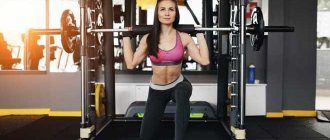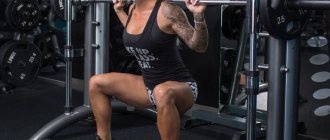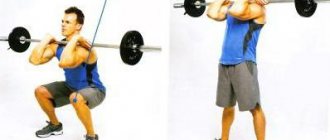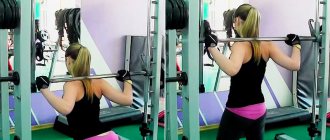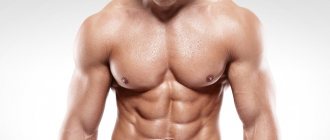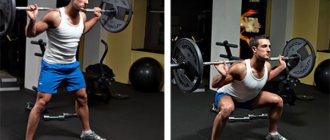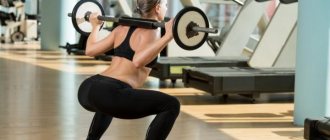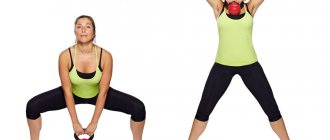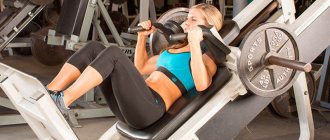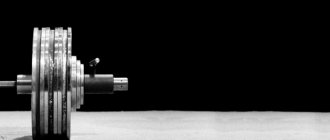- Previous
- Next
20.06.2016
Avoiding squats due to back pain? This exercise has worthy alternatives that provide comparable gains in strength and muscle mass.
Author: Jim Stoppani, Ph.D.
Can you imagine yourself in the shoes of a basketball player who has to replace Michael Jordan in the Chicago Bulls? Or in the post of Tim Cook, who continued the work of Steve Jobs at Apple? Or as the quarterback who will replace Tom Brady when he hangs up his cleats? The task is not easy.
My defense of exercises that can replace squats may be met with similar skepticism. Yes, the back squat is the “king of exercises” and I’m as big a fan of it as you are. But if you're concerned about the increased risk of injury, or you just absolutely hate squats, don't force yourself to do squats in the traditional sense.
However, I highly recommend incorporating some variation of squats into your training program regularly (at least once a week). This is a fundamental movement not only in the world of training and sports, but also in real life. I know barbell squats can be dangerous for your lower back and knee joints - believe me, I've had back problems too. But there are plenty of movement modifications that reduce stress on vulnerable areas and generate excellent growth stimuli for the glutes, quads, hamstrings and other parts of the body. In terms of effectiveness, these options are quite comparable to traditional squats with a barbell on the shoulders.
Below we will look at six such exercises. Incorporate either of these into your routine instead of standard squats, and you'll see (virtually) the same strength and muscle gains as the crowned king.
Alternative 1: Front Squats
Arguments in favor of replacement. It's still a squat, but since the bar is on the chest instead of the shoulders, the difference is very big. Compared to standard squats, front squats target the quads more than the glutes, so this is a great exercise for anyone looking to tone the front of their thighs.
Front Squats
But what is especially important for people with lower back pain, front squats force you to keep your body in the most vertical position (otherwise the barbell will fall to the floor), thereby reducing the load on the spine.
Expert advice. Cross your arms over your chest to create a “shelf” for the barbell. Use the grip that suits you best. Lower yourself until your thighs are almost parallel to the floor.
Kinds
Depending on what exactly you want to improve more, you choose one or another option for performing this exercise.
On the knees
Kneeling squats are rarely used in Smith. Most often - powerlifters and weightlifters. They apply stress at an unusual angle and affect areas of the body that everyone usually forgets about. The buttocks and thighs, semimembranosus and semitendinosus muscles are well worked out.
- Get on your knees so that they are slightly wider than shoulder-width apart.
- The shins run parallel to each other.
- Press your toes firmly into the floor.
- Bend your back slightly.
- Place the bar on the trapezius muscles.
- Lower yourself until your buttocks touch your calves. In this position, you need to feel what an excellent stretch the buttocks give from knee squats.
- Climb.
- In the upper position, a pause of 3-5 seconds is allowed.
Frontal
One of the varieties of classic exercises in the Smith machine is front squats, when the barbell needs to be held not on the shoulders, but on the chest. They work the abs, lower back and hips; reduce the load on the spine and knees; develop balance and accelerate fat burning.
- Cross your arms and place a barbell on them. Elbows should be parallel to the ground.
- Legs are at shoulder level, toes turned 45°.
- Tighten your abs.
- Keeping your back straight, begin to slowly lower yourself until your thigh is parallel to the floor.
- Push through your heels to return to the starting position.
It is believed that frontal exercises are more effective than classic ones, with a barbell on the shoulders. They reduce the risk of injury and better work out the hips and buttocks.
With different leg positions
It is very important how the legs are placed, as this distributes the load between the muscles.
- The standard pose pumps up the buttocks and thighs;
- wide squats (sumo), when the feet are far from each other - the inner thighs;
- exercise with narrow legs - outer thighs;
- High planting of the feet - buttocks and back of the thighs.
Squats are especially difficult when you need to put your feet together - this increases the load not only on the outer surface of the thighs, but also on the knee joints.
Bulgarian
In Smith, you can perform the famous Bulgarian squats on one leg (the second at this time is fixed on a hill), on which the entire load is concentrated.
- Remove the barbell from the machine and place it on the trapezius muscles.
- Place one foot behind you on a hill (just the toe or the whole foot - it doesn’t matter).
- Place the second one one step forward.
- Slowly lunge, placing all the weight on your front leg.
- Return to starting position.
- Do the same with the other leg.
There is no need to combine different variations of squats in the Smith machine in one program, planning to pump up all the muscles at once. This will result in excessive stress and complete loss of strength. Set a goal - choose the position of your legs - train according to the chosen scheme - achieve the desired result.
This is interesting. The creator of the Smith Machine, Jack Lalane, was a bodybuilder, nutritionist, naturopath, led a healthy lifestyle, ate right and promoted the dangers of food additives. He died in 2011 at the age of 96.
Alternative 2: Jefferson Squats
Arguments in favor of replacement. The exercise is often called a Jefferson deadlift, but because your back is upright, it's more like a squat than a traditional deadlift, where you have to lean forward because the bar is in front of your legs. In this variation, you need to “saddle” the barbell. A straight back is the main reason why many people choose Jefferson squats for spinal problems.
Expert advice. The body is tense, chest forward, back straight, rise with the barbell by extending the knee and hip joints, pushing off with the heels. As you reverse the movement, allow your buttocks to lean back slightly. When your thighs are parallel to the floor or the bar touches the ground, return to a standing position.
Alternative 3: Zercher Squats
Arguments in favor of replacement. Zercher squats are another great option for reducing stress on your lower back. The bar is located much lower (in the center of the body, and not on the shoulders), as a result of which the effect of compression force on the spine is significantly reduced. Similar to front squats, Zercher squats force you to keep your torso as vertical as possible while also allowing you to squat quite deeply.
Zercher Squats
Expert advice. Hang the barbell in a power rack below shoulder height. Place the barbell on the crook of your elbows, bent at a 90-degree angle. Bend your knees and hips; let your buttocks move back a little; lower yourself to the bottom position. When your thighs are parallel to the floor, generate force from your heels to return to a standing position.
Benefits of exercise
In strength sports, squats with a barbell occupy the first place of honor. In terms of effectiveness, only the deadlift can compete with it.
When performing this movement, about 250 muscles are involved.
Main working muscles:
- Quadriceps
- Gluteal
- Hamstrings
The calves, lumbar and abs stabilize the body. Plus, the lungs and chest work hard.
Barbell squats are the leader among exercises that provoke the release of testosterone into the blood.
The higher the level of this male sex hormone, the faster the growth of muscle mass and strength.
Thus, classic squats promote the growth of not only leg muscles, but also other parts of the body.
This exercise is also effective for terrain training. The point of working out in the gym at this time is to burn as many calories as possible. And here squats with a barbell on the shoulders are the undisputed leaders.
Other positive effects include:
- Training and strengthening the cardiovascular system
- Development of core and lower back muscles
- Strengthening the osseous-ligamentous apparatus, etc.
This list is not so easy to complete, but even from the above it becomes clear that this is one of the most effective strength exercises, which is difficult to do without in training. Difficult, but possible.
Let’s talk further about how you can replace squats.
Alternative 4: Single Leg Squats
Arguments in favor of replacement. The single-leg squat exercise has several other names (such as Bulgarian split squats), perhaps because it is a cross between squats and lunges - legs apart, one leg in front, the other in back. A lunge-like position helps keep your back perpendicular to the floor and prevents you from leaning dangerously forward, which often causes lower back pain.
Since one leg is behind you, you can move your front leg as far forward as necessary to protect the knee joint from unnecessary stress. In this exercise, you have a choice: you can put a barbell on your shoulders or pick up dumbbells.
Expert advice. If you choose dumbbells, grip strength may be the limiting factor; in this case, switch to the barbell. Bend your front knee and hip. Lower yourself down until your front thigh is parallel to the floor. As you move up, push through your heel and return to the starting position, using your back leg to balance.
How to replace squats for women
Romanian Deadlift: An essential compound glute training exercise for women with thick bones and lots of muscle fibers. It is important to understand that girls need to innervate the gluteal muscle in this exercise, so the feet and knees need to be turned slightly to the sides, and not perform the exercise as suggested by the classical technique , since turning the feet will allow you to “immanently” innervate the gluteal muscle. The Romanian deadlift will replace squats as a basic mass-building exercise, so it should be used only during the period of mass gain, the rest of the time giving preference to isolation.
Isolation: This is a very wide range of exercises that allows you to specifically concentrate the load only on the gluteal muscle, and sometimes on its specific heads. It is clear that it is impossible to completely exclude the work of synergists, but, in general, the load falls only on the target muscle group. There are many such exercises, so it’s best for you to read the article dedicated exclusively to training the gluteal muscles for women , which we wrote earlier. But, conceptually, the point is that if your gluteal muscle is well defined, you don’t want to make it bigger, but just want to tone it, so you need to use formative exercises, not basic exercises.
Alternative 5: Smith Machine Squats
Arguments in favor of replacement. Anyone who blames the Smith machine for its lack of “practicality” is not opening their mind to the possibilities that this training tool offers. When applied to squats, the Smith machine has a number of undeniable advantages:
- Allows you to safely overload your lower body with heavy weights and maximize mass and strength gains without having to worry about balancing.
- Allows you to change the position of your feet and use different parts of your legs. For example, by moving your feet further forward (this will not work with a barbell), you will shift the load to the gluteal muscles, which will be very appealing to those who want to pump up this area with emphasis.
- Decreases ankle flexion and reduces stress on the knees as the feet move forward. Think of lunges, where a wider step forward prevents your knees from going past the plane of your toes.
Smith machine squats
Expert advice. Smith machine squats are a particularly good choice if you're performing the exercise at the end of a training session. For example, when you want to work your muscles with less weight against the background of preliminary fatigue. If you squat on an incline machine rather than a vertical one (the bar moves up and down), place your feet at the front edge of the frame and look forward to make it easier to follow the natural trajectory of the barbell.
Alternative 6: Barbell Hack Squats
Arguments in favor of replacement. At first glance, the exercise may seem a little strange, as if you were doing a deadlift in reverse, because the barbell is behind your legs, not in front of them. But that's the way it's meant to be. In fact, barbell hack squats have been around for many decades, much longer than the machine hack squats found in most commercial gyms.
This movement is unique because the bar is at the rear. The load on the lower back is lower compared to a standard deadlift because you don't have to lean forward as much. This position makes it much easier to keep your center of gravity over your heels, as you would during a standard barbell squat. This is a key benefit for people with low back problems.
Expert advice. Both palms can face backwards, but if you prefer, you can also use a cross grip, in which one palm faces forward and the other back. Keep your back straight (don't round your lower back) and your spine neutral during both the positive and negative phases of each repetition.
Smith vs Barbel, or which is better: a machine or a barbell?
Training with free weights is more promising than training on machines. Many people think so. But exercise machines also have their advantages. Which ones?
Strictly speaking, we already know that a progressive increase in working weight leads to an increase in strength indicators both when training with free weights and when training in a Smith machine (2.10). In fact, the main advantage of working with free weights is the fact that in this case the sports equipment must be controlled in three planes, which inevitably engages and thereby trains the stabilizer muscles (5). However, exercising in a car may be safer for the same reason (1). At the same time, the simulator allows you to work with extra-maximum weights, again due to the absence of the need to balance the weight (7). Although, of course, the problem of skill transfer remains: in a real situation, the weight still has to be balanced, and the trajectories of the bar movement in the simulator and in real conditions differ significantly (3,9,12). As a result, the strength developed on the simulator (skill) turns out to be of little use in competitions (4,6,7).
Researchers from the University of Illinois (USA) measured muscle activity using electromyography (8). They compared the force applied by an athlete to the same weight in the bench press using a barbell and using a Smith machine. The grip width was the same in all cases. Recoil from the chest was prohibited. The participants in the experiments were experienced powerlifters who had experience working in the Smith machine. Two loads were used in the experiments: 60% and 80% of 1RM. 5 repetitions were performed with both weights. EMG was taken from the triceps, deltoids, biceps and pectoralis major muscles.
Experiments by McCaw and Friday (8) showed that muscle activity was greater when lifting free weights, and this was more noticeable at 60% weight. This difference in effort is especially noticeable for the deltoid muscles when working with a weight of 60%, which is associated with the stabilizing function of these muscles during the bench press (11). At the same time, the anterior deltoid bundle developed maximum force. However, the activity of the pectoralis major muscles when lifting weights in the machine press was higher compared to the free weight press (for both 60% and 80%). Presumably, this is due to the fact that the experiment involved experienced athletes who have the skill of “tearing” a barbell from the chest due to a complex of muscles, and not due to the pectoral muscles alone, and since in a machine, due to the unnatural trajectory of the projectile, It turned out to be impossible to use the established model; the athletes had to reflexively overload the large pectoral muscles in order to ensure that the stay was torn off the chest.
The overall conclusion, in my opinion, is that Smith machine bench training is quite acceptable for bodybuilders who only care about muscle size. For powerlifters, working in a machine is impractical and possibly harmful due to the development of skills that are unacceptable for use in real training and tournament conditions.
Literature
1. Ariel, GB Resistive training. Clin. Sports Med. 2(1):55-69. 1983. 2. Coleman, AE Nautilus vs universal gym strength training in adult males. Am. Corr. Ther. J. 103-107. July-Aug. 1977. 3. Elliott, B. C., G. J. Wilson, and G. K. Kerr. A biomechanical analysis of the sticking region in the bench press. Med. Sci. Sports Exerc. 21:450-461. 1989. 4. Garhammer, J. Sports Illustrated Strength Training. New York: Winner's Circle Books, 1984. 5. Garhammer, J. Weight lifting and training. In: Biomechanics of Sport. C. L. Vaughn, ed. Boca Raton, FL: CRC Press, 1989, pp. 169-211. 6. Hatfield, FC Bodybuilding: A Scientific Approach. Chicago: Contemporary Books, 1984. 7. Lander, J. E., B. T. Bates, J. A. Sawhill, and J. Hamill. A comparison between free-weight and isokinetic bench pressing. Med. Sci. Sports Exerc. 17:344-353. 1985. 8. McCaw, S. T., and J. J. Friday. A comparison of muscle activity between a free weight and machine bench press. J. Strength and Cond. Res. 8(4):259-264. 1994. 9. Madsen, N., and T. McLaughlin. Kinematic factors influencing performance and injury risk in the bench press exercise. Med. Sci. Sports Exerc. 16:376-381. 1984. 10. McDonagh, M. J., and C. T. Davies. Adaptive responses of mammalian skeletal muscle to exercise with high loads. Eur. J. Appl. Physiol. 52:139-155. 1984. 11. Scheving, L. E., and J. E. Pauly. An electromyographic study of some muscles acting on the upper extremity of man. Anat. Rec. 135:239-246. 1959. 12. Wilson, G. J., B. C. Elliott, and G. K. Kerr. Bar path and force profile characteristics for maximal and submaximal loads in the bench press. Int. J. Sport Biomech. 5:390-402. 1989.
